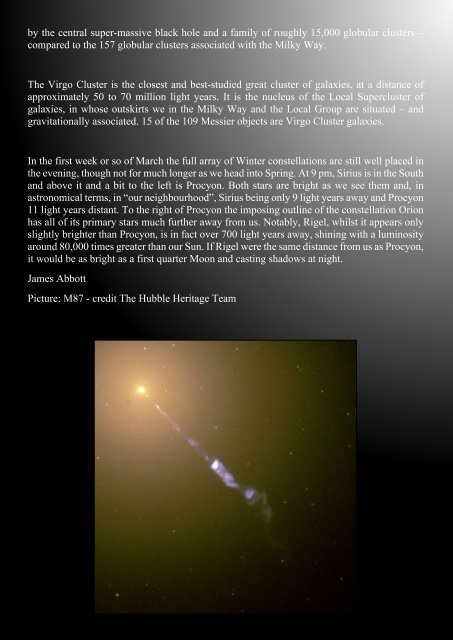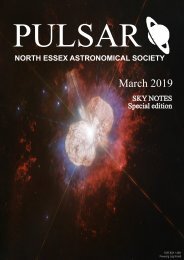Sky Notes March 19 turn
You also want an ePaper? Increase the reach of your titles
YUMPU automatically turns print PDFs into web optimized ePapers that Google loves.
y the central super-massive black hole and a family of roughly 15,000 globular clusters –<br />
compared to the 157 globular clusters associated with the Milky Way.<br />
The Virgo Cluster is the closest and best-studied great cluster of galaxies, at a distance of<br />
approximately 50 to 70 million light years. It is the nucleus of the Local Supercluster of<br />
galaxies, in whose outskirts we in the Milky Way and the Local Group are situated – and<br />
gravitationally associated. 15 of the 109 Messier objects are Virgo Cluster galaxies.<br />
In the first week or so of <strong>March</strong> the full array of Winter constellations are still well placed in<br />
the evening, though not for much longer as we head into Spring. At 9 pm, Sirius is in the South<br />
and above it and a bit to the left is Procyon. Both stars are bright as we see them and, in<br />
astronomical terms, in “our neighbourhood”, Sirius being only 9 light years away and Procyon<br />
11 light years distant. To the right of Procyon the imposing outline of the constellation Orion<br />
has all of its primary stars much further away from us. Notably, Rigel, whilst it appears only<br />
slightly brighter than Procyon, is in fact over 700 light years away, shining with a luminosity<br />
around 80,000 times greater than our Sun. If Rigel were the same distance from us as Procyon,<br />
it would be as bright as a first quarter Moon and casting shadows at night.<br />
James Abbott<br />
Picture: M87 - credit The Hubble Heritage Team




